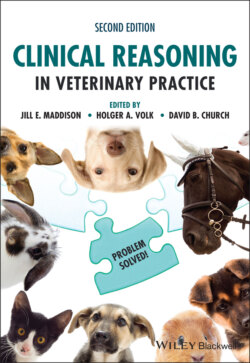Читать книгу Clinical Reasoning in Veterinary Practice - Группа авторов - Страница 57
Clues to help differentiation of vomiting, regurgitation and reflux
ОглавлениеThe associated behaviour of patients who vomit differs from those who regurgitate or reflux. As discussed, vomiting is a neurologically coordinated activity with defined stages and physical manifestations. The patient will exhibit abdominal effort prior to bringing up material, and vomiting is often preceded by hypersalivation – manifested by licking of lips and repeated swallowing. The vomiting may be projectile.
In contrast, regurgitation and reflux are passive processes – there are no coordinated movements. Regurgitation is often induced or exacerbated by alterations in food consistency and exercise and facilitated by gravity when the head and neck are held down and extended. Patients who regurgitate will often gag as material accumulates in the pharynx. Reflux is often watery and low in volume but acidic, and patients may exhibit behaviour indicating local irritation.
The character of the vomitus may also give the clinician clues. While undigested food may be brought up by vomiting or regurgitation, if the food is partially digested and/or contains bile, the patient is vomiting and/or refluxing, not regurgitating. The pH of the vomitus is occasionally, but not always, useful. Acidic material strongly suggests vomiting or reflux, but pH‐neutral material may be the product of vomiting, reflux or regurgitation.
As mentioned, because the epiglottis does not close, regurgitating patients are at considerable risk of aspirating gastric contents. Thus, if an owner reports that his/her animal developed a cough at the same time it started ‘vomiting’, the clinician should be alert to the possibility that aspiration has occurred and that this is more likely to occur with regurgitation than vomiting.
There is a caveat, however, which should be kept in mind. Patients who have experienced serious vomiting of acidic gastric contents may develop a secondary oesophagitis and present with signs suggestive of both vomiting and regurgitation or reflux. Usually, vomiting will have been the first sign noted. Animals that ingest caustic or irritant material causing oesophagitis and gastritis may also present with signs of both vomiting and regurgitation.
